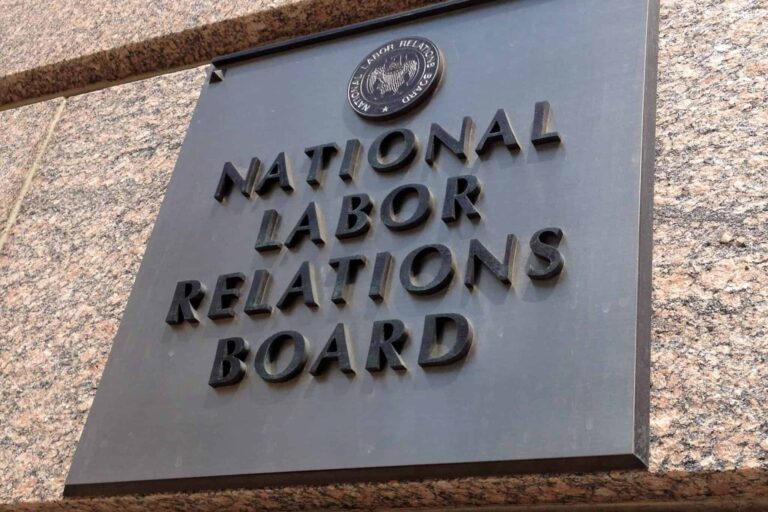
Darin M. Dalmat is a Senior Partner at Barnard, Iglitzin, & Lavitt LLP—a law firm in Seattle, Washington, that represents unions.
The Basis For and Development of Deference to the Board
Studying deference to the Board may foreshadow via the rearview mirror—a post-Chevron world might look like a pre-Chevron world. Let’s begin at the beginning.
Congress passed the NLRA in 1935. Section 1 declared it “the policy of the United States to eliminate the causes of certain substantial obstructions to the free flow of commerce … by encouraging the practice and procedure of collective bargaining and by protecting the exercise by workers of full freedom of association, self-organization, and designation of representatives of their own choosing, for the purpose of negotiating the terms and conditions of their employment or other mutual aid or protection.” c. 327, 74 Stat. 449, 449 (1935). Section 2 defined terms. Sections 3–5 established the NLRB. Section 6 authorized it to make rules. Section 7 established employees’ rights “to self-organization, to form, join, or assist labor organizations, to bargain collectively through representatives of their own choosing, and to engage in concerted activities, for the purpose of collective bargaining or other mutual aid or protection.” Id. at 452. Section 8 specified employers’ unfair labor practices (ULPs), including interference with employees’ section 7 rights. Id. at 453. Section 9 provided for designation or election of representatives. Id.
And, critically, Section 10 created the process for preventing ULPs. It “empowered” the Board “to prevent any person” from engaging in a ULP—a power Congress declared “exclusive” and not to be “affected by any other means of adjustment or prevention that has been or may be established by agreement, code, law, or otherwise.” Id. at 453. The process begins when a person files a charge and the Board issues a complaint. Id. at 453. The Board then holds a hearing, takes testimony, and renders an “opinion” on whether a ULP has occurred. Id. at 453–54. If so, the Board “shall state its findings of fact and shall issue … an order requiring such person to cease and desist from such unfair labor practice, and to take such affirmative action … as will effectuate the policies of this Act.” Id. at 454. But if the Board opines no ULP occurred, it “shall state its findings of fact and shall issue an order dismissing the said complaint.” Id. The Board can petition a federal court of appeals to enforce its orders. Id. In those proceedings, its factual findings, supported by evidence (post-1947, “substantial evidence”), “shall be conclusive.” Id. Parties may ask the reviewing court to order additional factual finding by the Board or for judicial review under the same standards applicable in Board-petitioned review. Id. at 454–55.
The Court first considered the upshot of this statutory design on judicial review in NLRB v. Pennsylvania Greyhound Lines, 303 U.S. 261 (1938), unanimously holding that “inferences to be drawn” about remedies to effectuate the Act’s policy “were for the Board and not the courts.” Id. at 271.
Congress significantly amended the Act three times (in 1947, 1959, and 1974) since Pennsylvania Greyhound. None of those amendments alter the statutory features that give rise to judicial deference: Congress has empowered the Board to prevent ULPs—capaciously stated statutory wrongs that infringe on equally capacious statutory rights—in a manner that shall be unaffected by other law-given means; and has compelled the Board—after charge, complaint, and hearing—to find facts, render opinions on the occurrence of ULPs, and issue remedial orders that effectuate the declared policies of the Act, namely to encourage collective bargaining and protect workers’ associational freedom. 29 U.S.C. §§ 151, 157, 158, 160.
Perhaps unsurprisingly, then, from 1938 through 1984—when Chevron issued—the Court repeatedly deferred to reasonable Board interpretations. See, e.g., IAM, Lodge No. 35 v. NLRB, 311 U.S. 72, 82 (1940); Phelps Dodge Corp. v. NLRB, 313 U.S. 177, 197 (1941); Virginia Electric & Power Co. v. NLRB, 319 U.S. 533, 539 (1943); NLRB v. Hearst Publications, 322 U.S. 111, 131 (1944); Republic Aviation Corp. v. NLRB, 324 U.S. 793, 798 (1945); NLRB v. Denver Bldg. & Constr. Trades Council, 341 U.S. 675, 692 (1951); NLRB v. Erie Resistor Corp., 373 U.S. 221, 236 (1963); NLRB v. Gissel Packing Co., 395 U.S. 575, 612 n.32 (1969); NLRB v. Natural Gas Utility Dist., 402 U.S. 600, 605 (1971); NLRB v. J. Weingarten, Inc., 420 U.S. 251, 266–67 (1975); NLRB v. Iron Workers No. 103, 434 U.S. 335, 350 (1978); Beth Israel v. NLRB, 437 U.S. 483, 500–01 (1978); Ford Motor Co. v. NLRB, 441 U.S. 488, 495 (1979); NLRB v. City Disposal Systems, Inc., 465 U.S. 822, 829 (1984); Sure-Tan, Inc. v. NLRB, 467 U.S. 883, 891 (1984).
It has continued to do so since Chevron—often citing NLRB-deference precedent, not Chevron itself. Pattern Makers v. NLRB, 473 U.S. 95, 100 (1985); NLRB v. UFCW, Local 23, 484 U.S. 112, 123–24 (1987); NLRB v. Curtin Matheson Scientific, Inc., 494 U.S. 775, 786–87 (1990); Litton Fin. Printing Div. v. NLRB, 501 U.S. 190, 200 (1991); ABF Freight Sys., Inc. v. NLRB, 510 U.S. 317, 324 (1994); Allentown Mack Sales & Service, Inc. v. NLRB, 522 U.S. 359, 364 (1998).
The Court has offered several explanations for this deference:
- Remedial Discretion: The statutory mandate to fashion remedies that effectuate the Act’s declared policies necessarily calls for the exercise of judgment and discretion. E.g., Pennsylvania Greyhound, Phelps Dodge, Sure-Tan.
- Statutory Duty to Find Capaciously-Stated Wrongs in Particular Circumstances: Congress used capacious language to define statutory rights and wrongs, while charging the Board with the duty, in the first instance, to find facts and render opinions determining when those wrongs occur, thus necessarily endowing the Board with discretion in rendering those opinions. E.g., Hearst Publications, 322 U.S. at 131; Republic Aviation, 324 U.S. at 798; Erie Resistor, 373 U.S. at 236; Ford Motor, 441 U.S. at 495; City Disposal, 465 U.S. at 829–30; Pattern Makers, 473 U.S. at 114.
- Duty to Adapt the Act: Congress entrusted the Board with the responsibility “to adapt the Act to changing patterns of industrial life … ,” in light of its “cumulative experience in dealing with labor–management relations.” Weingarten, 420 U.S. at 266.
- Administrative Expertise: The Board’s experience with the spectrum of labor relations across industries gives it an expertise in finding wrongs and fashioning remedies. Gissel Packing, 395 U.S. at 612 n.32; Beth Israel, 437 U.S. at 501.
- Balancing Conflicting Interests: Congress charged the Board with the responsibility of balancing conflicting interests to effectuate national labor policy. Truck Drivers, 353 U.S. at 96; Iron Workers No. 103, 434 U.S. at 350. But see Gali Racabi, Balancing is for Suckers, 109 Cornell L. Rev. (forthcoming).
To this list, I offer one more. Reviewing Board orders de novo would directly defy the Act’s plain text because a court’s independent take on when a ULP has occurred or how best to remedy it would be a “means of adjustment or prevention” of ULPs “established by … law,” 29 U.S.C. § 160(a), notwithstanding Congress’s command that the Board’s power to prevent ULPs shall be unaffected by such other means.
The views and opinions expressed in this article are those of the author and do not necessarily reflect the views or positions of any entities that the author represents.









Daily News & Commentary
Start your day with our roundup of the latest labor developments. See all
April 26
Starbucks and Workers United resume bargaining talks; Amazon is ordered to disclose records; Alabamians support UAW’s unionization efforts.
April 25
FTC bans noncompete agreements; DOL increases overtime pay eligibility; and Labor Caucus urges JetBlue remain neutral to unionization efforts.
April 24
Workers in Montreal organize the first Amazon warehouse union in Canada and Fordham Graduate Student Workers reach a tentative agreement with the university.
April 23
Supreme Court hears cases about 10(j) injunctions and forced arbitration; workers increasingly strike before earning first union contract
April 22
DOL and EEOC beat the buzzer; Striking journalists get big NLRB news
April 21
Historic unionization at Volkswagen's Chattanooga plant; DOL cracks down on child labor; NY passes tax credit for journalists' salaries.